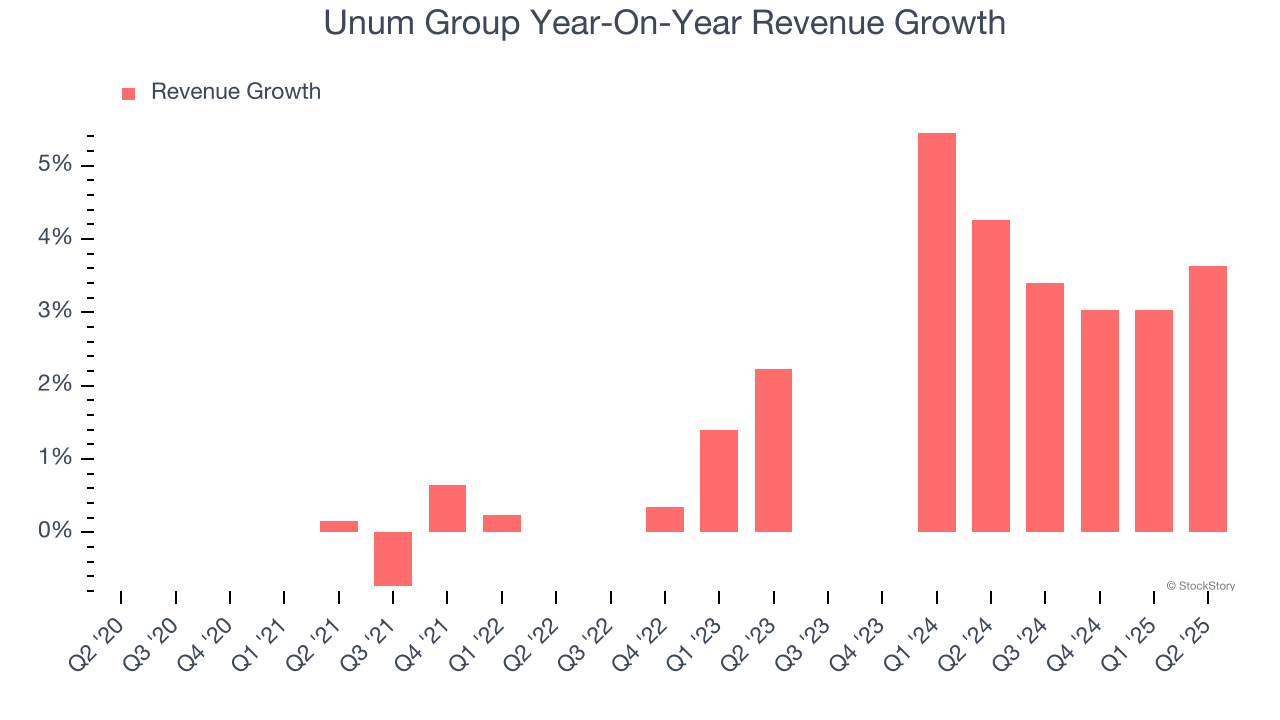
Employee benefits provider Unum Group (NYSE:UNM) reported Q2 CY2025 results topping the market’s revenue expectations, with sales up 3.6% year on year to $3.36 billion. Its non-GAAP profit of $2.07 per share was 6.5% below analysts’ consensus estimates.
Is now the time to buy Unum Group? Find out by accessing our full research report, it’s free.
Unum Group (UNM) Q2 CY2025 Highlights:
- Net Premiums Earned: $2.75 billion vs analyst estimates of $2.74 billion (4.6% year-on-year growth, in line)
- Revenue: $3.36 billion vs analyst estimates of $3.33 billion (3.6% year-on-year growth, 0.9% beat)
- Pre-Tax Profit Margin: 12.4% (2.9 percentage point year-on-year decrease)
- Adjusted EPS: $2.07 vs analyst expectations of $2.21 (6.5% miss)
- Market Capitalization: $13.96 billion
“During the quarter we made meaningful progress against our strategic priorities, despite earnings results that did not meet our expectations,” said Richard P. McKenney, president and chief executive officer.
Company Overview
Tracing its roots back to 1848 when financial security for workers was virtually non-existent, Unum Group (NYSE:UNM) provides workplace financial protection benefits including disability, life, accident, critical illness, dental and vision insurance primarily through employers.
Revenue Growth
Insurance companies earn revenue from three primary sources:
- The core insurance business itself, often called underwriting and represented in the income statement as premiums
- Income from investing the “float” (premiums collected upfront not yet paid out as claims) in assets such as fixed-income assets and equities
- Fees from various sources such as policy administration, annuities, or other value-added services
Unfortunately, Unum Group’s 1.8% annualized revenue growth over the last five years was sluggish. This was below our standards and is a poor baseline for our analysis.

We at StockStory place the most emphasis on long-term growth, but within financials, a half-decade historical view may miss recent interest rate changes, market returns, and industry trends. Unum Group’s annualized revenue growth of 4.2% over the last two years is above its five-year trend, but we were still disappointed by the results.  Note: Quarters not shown were determined to be outliers, impacted by outsized investment gains/losses that are not indicative of the recurring fundamentals of the business.
Note: Quarters not shown were determined to be outliers, impacted by outsized investment gains/losses that are not indicative of the recurring fundamentals of the business.
This quarter, Unum Group reported modest year-on-year revenue growth of 3.6% but beat Wall Street’s estimates by 0.9%.
Net premiums earned made up 80.3% of the company’s total revenue during the last five years, meaning Unum Group barely relies on non-insurance activities to drive its overall growth.

Markets consistently prioritize net premiums earned growth over investment and fee income, recognizing its superior quality as a core indicator of the company’s underwriting success and market penetration.
Unless you’ve been living under a rock, it should be obvious by now that generative AI is going to have a huge impact on how large corporations do business. While Nvidia and AMD are trading close to all-time highs, we prefer a lesser-known (but still profitable) stock benefiting from the rise of AI. Click here to access our free report one of our favorites growth stories.
Book Value Per Share (BVPS)
Insurance companies are balance sheet businesses, collecting premiums upfront and paying out claims over time. The float – premiums collected but not yet paid out – are invested, creating an asset base supported by a liability structure. Book value captures this dynamic by measuring:
- Assets (investment portfolio, cash, reinsurance recoverables) - liabilities (claim reserves, debt, future policy benefits)
BVPS is essentially the residual value for shareholders.
We therefore consider BVPS very important to track for insurers and a metric that sheds light on business quality because it reflects long-term capital growth and is harder to manipulate than more commonly-used metrics like EPS.
Unum Group’s BVPS grew at a tepid 4.8% annual clip over the last five years. However, BVPS growth has accelerated recently, growing by 18.2% annually over the last two years from $47.06 to $65.76 per share.

Over the next 12 months, Consensus estimates call for Unum Group’s BVPS to grow by 24.4% to $77.57, elite growth rate.
Key Takeaways from Unum Group’s Q2 Results
It was good to see Unum Group narrowly top analysts’ revenue expectations this quarter. We were also happy its net premiums earned was in line with Wall Street’s estimates. On the other hand, its book value per share missed and its EPS fell short of Wall Street’s estimates. Overall, this was a softer quarter. The stock traded down 4.9% to $77 immediately following the results.
Unum Group may have had a tough quarter, but does that actually create an opportunity to invest right now? When making that decision, it’s important to consider its valuation, business qualities, as well as what has happened in the latest quarter. We cover that in our actionable full research report which you can read here, it’s free.
